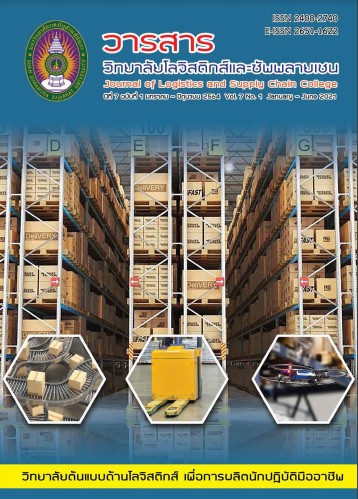The The Marketing Mix (4C’s), Service Quality and Attitudes in Using Food Delivery Application to Affecting Consumer’s Decision
Keywords:
The Marketing Mix, Service Quality, Consumer’s Attitudes, Using Food Delivery Application, Buying DecisionAbstract
The objective of this research was to find the relationship between the marketing mix (4C’s), service quality, and customer’s attitudes in using food delivery applications. It was quantitative research. The research population was the infinite population and indefinite area. A sample of 845 cases was drawn by non- probability sampling as a purpose sample from customers using food delivery applications. The research tool was a questionnaire. Data were gathered by an online questionnaire and analyzed by the Multiple Regression Analysis method to create a predicting equation. As a result, all factors including the marketing mix (4C’s), service quality, and customer’s attitudes, could predict consumer’s buying decisions. Consumers’ attitudes had the biggest effect on buying decisions, followed by convenience to buy. Moreover, all factors had a positive relationship affecting in the same direction and relating to the studied hypothesis. Hence, both new and existing restaurants entering the market of food delivery applications following the Covid-19 pandemic should customer’s attitudes wherewith the different application, convenience to buy, promotion, restaurant ranking even though delivery charge was different. Hence, Operator should consider for all to improve their business for success and sustainability.
References
กนกวรรณ นุชนารถ, จิราภา พนารินทร์, ธนภรณ์ ปิยพิทักษ์บุญ, ภัทธนัน สาระโชติ, ธรณิศร นาคสัมพันธ์, ศุภชัย เหมือนโพธิ์ และทาริกา สระทองคำ. (2562). ปัจจัยที่มีอิทธิพลต่อการตัดสินใจเลือกใช้บริการ Food Delivery. วารสารมนุษยศาสตร์และสังคมศาสตร์ มหาวิทยาลัยเอเชียอาคเนย์, 13(2), 44-53.
เกตุวดี สมบูรณ์ทวี. (2561). ปัจจัยด้านคุณภาพการบริการที่มีอิทธิพลต่อการตัดสินใจซื้อซ้ำผลิตภัณฑ์อาหารผ่านผู้ให้บริการ “Food Panda Application”. Modern Management Journal, 16(1), 153-162.
ชวกร อมรนิมิต. (2559). การทำการตลาดตามรูปแบบการดำเนินชีวิตที่มีอิทธิพลต่อการตัดสินใจใช้ธุรกิจเดลิเวอรีอาหารแบบบริการถึงบ้านของผู้บริโภคในเขตกรุงเทพมหานคร. การค้นคว้าอิสระบริหารธุรกิจมหาบัณฑิต มหาวิทยาลัยกรุงเทพ.
ณัฐชา มาตุภูมานนท์. (2558). ปัจจัยที่มีผลต่อการตัดสินใจซื้อบ้านสั่งสร้างเอสซีจี ไฮม์ (SCG HEIM) ของผู้บริโภคในเขตกรุงเทพมหานคร และปริมณฑล. การค้นคว้าอิสระนี้เป็นส่วนหนึ่งของการศึกษาตามหลักสูตรบริหารธุรกิจมหาบัณฑิต. มหาวิทยาลัยธรรมศาสตร์.
พิมพงา วีระโยธิน และธรรญธร ปัญญโสภณ. (2561). ปัจจัยที่ส่งผลให้ผู้บริโภคตัดสินใจใช้แอปพลิเคชัน อูเบอร์อีท (Uber Eats) เพื่อบริการรับส่งอาหาร (Food Delivery). รายงานสืบเนื่องการประชุมวิชาการและนำเสนอผลงานวิจัยระดับชาติ ครั้งที่ 2 ประจำปี 2561, วันที่ 30 พฤศจิกายน 2561 ณ มหาวิทยาลัยสวนสุนันทา, 708-717.
พิมพุมผกา บุญธนาพีรัชต์. (2560). ปัจจัยส่วนประสมทางการตลาดที่มีผลต่อการตัดสินใจใช้บริการ Food Delivery ในเขตกรุงเทพมหานครและปริมณฑล. การค้นคว้าอิสระปริญญามหาบัณฑิต. มหาวิทยาลัยธรรมศาสตร์.
ศิริวรรณ เสรีรัตน์. (2550). พฤตกิรรมผู้บริโภค. กรุงเทพฯ: บริษัท ธีระฟิล์มและไซเท็ก จำกัด.
ศูนย์วิจัยกสิกรไทย. (2563). หลังโควิด-19 ธุรกิจ Food Delivery ขยายตัวบนการแข่งขันที่ยิ่งรุนแรงผู้ให้บริการแพลตฟอร์มรุกไปสู่ Super Application. กระแสทรรศน์ ฉบับที่ 3128. [ออนไลน์]. ค้นเมื่อ 16 ตุลาคม 2563, จาก: https://www.kasikornresearch.com/th/analysis/k-econ/business/Pages/z3128-Food-Delivery.aspx.
ศูนย์วิจัยกสิกรไทย. (2562). การแข่งขันของแอปพลิเคชั่นสั่งอาหาร ดันธุรกิจ Food Delivery เติบโตต่อเนื่อง คาดมีมูลค่าสูงถึง 33,000 – 35,000 ล้านบาท ในปี 2562. กระแสทรรศน์ ฉบับที่ 2995. ค้นเมื่อ 16 ตุลาคม 2563, จาก: https://www.kasikornresearch.com/th/analysis/k-econ/business/Pages/z2995.aspx.
เสรี วงษ์มณฑา. (2554). การวิเคราะห์พฤติกรรมผู้บริโภค. กรุงเทพฯ: บริษัท ธีระฟิล์มและไซเท็กซ์ จำกัด.
สสินาท แสงทองฉาย และธาตรี ใต้ฟ้าพูล. (2562). ปัจจัยส่วนประสมทางการตลาดที่มีอิทธิพลต่อพฤติกรรมของผู้บริโภคกลุ่มดิจิทัลเนทีฟไทยในการเลือกใช้แอปพลิเคชันสั่งและจัดส่งอาหารในเขตกรุงเทพมหานคร. Journal of Public Relations and Advertising, 12(1), 13-31.
Cohen, J., Cohen, P., West, S. G., & Aiken, L. S. (2013). Applied multiple regression/correlation analysis for the behavioral sciences. Routledge.
Kotler, P., & Keller, K. L. (2012). Marketing Management (14th Global ed.). Pearson Education
Kotler, P. & Armstrong, G. (2018). Principles of marketing (17th ed.). New Jersey: Prentice Hall
Kotler, P. & Keller, K. L. (2016). Marketing management (15th ed.). New Jersey: Prentice Hall.
Kang, J. W., & Namkung, Y. (2019). The role of personalization on continuance intention in food service mobile apps. International Journal of Contemporary Hospitality Management.
Lauterborn, R. F., Schullz, D. E. &Tannenbaum, S. I. (Eds). (1993). Integrated marketing communications. 1st Edition, U.S.: NTC Business Books, a division of NTC Publishing.
O’Brien, R. M. (2007). A caution regarding rules of thumb for variance inflation factors. Quality & Quantity, 41(5), 673–690.
Yamane, T. (1973). Statistics, an introductory analysis (3rded.). New York: Harper and Row Publication.



